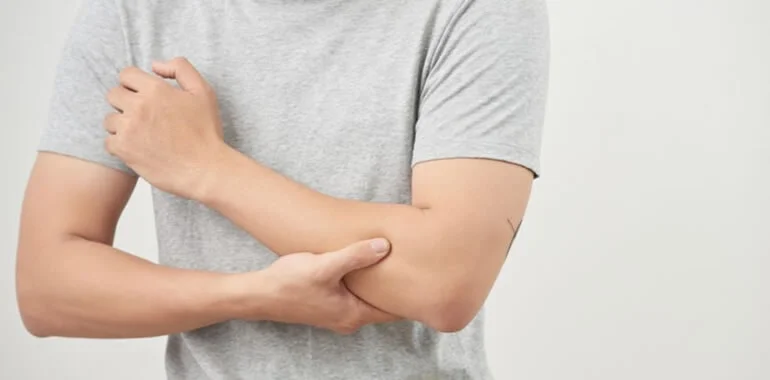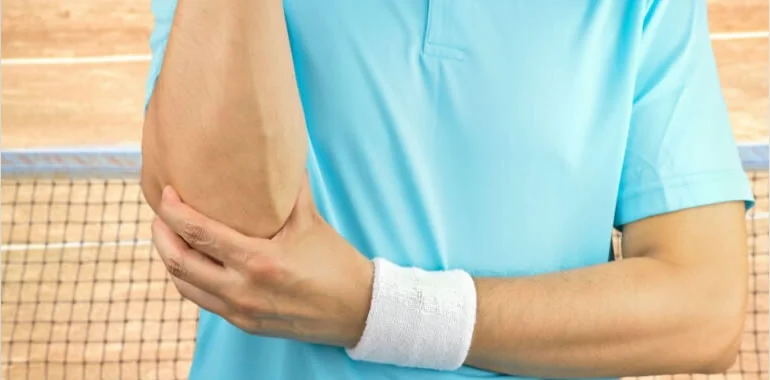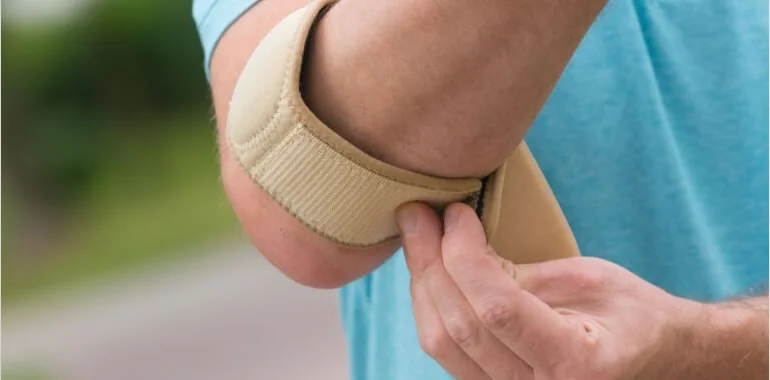
Have you heard people talking about these two conditions or been told by your MD that you have one, but you are unsure what they are or what to do about it?
Well, we know they sound similar, and people often confuse them, but they’re actually two different conditions with different symptoms. Let’s go through them one by one – starting with Medial Epicondylitis (golfer’s elbow).
Read More Blogs By ProActive Physical Therapy & Wellness Here:
What Is Medial Epicondylitis?
If you get pain in your arm when you try to grip something, twist a handle, or shake someone’s hand, you might be struggling with Medial Epicondylitis (often referred to as “golfer’s elbow”). This condition is an inflammation of the inner part of the elbow that causes painful symptoms.
It affects many people who participate in activities that require repetitive hand and wrist movements. While it can be frustrating to deal with this condition, the good news is that treatments are available to help ease your pain.
With early diagnosis and physical therapy treatment, it’s reasonably easy to manage this condition and get back on track to better health.
But what causes it?
Medial Epicondylitis is caused by repetitive wrist and arm motions, which stress the tendons that connect to the “medial epicondyle,” a bony bump on the inside of your elbow. Overusing these tendons can cause tiny tears, leading to pain, stiffness, and weakness.
We typically see Medial Epicondylitis in athletes and people who engage in repetitive activities such as typing on a keyboard, painting, or carpentry.
What Are The Symptoms Of Medial Epicondylitis?

If you get pain inside your elbow after playing tennis or golf, it could be a telltale sign of Medial Epicondylitis (Golfer’s Elbow). As we already mentioned, it’s caused by overuse of the forearm muscles and tendons that attach to the medial epicondyle. The symptoms of Golfer’s Elbow can vary, but the most common ones include:
If you have any of these symptoms and suspect you might have Medial Epicondylitis, it’s important to seek treatment, as it can worsen without proper care. The most effective treatment for Medial Epicondylitis that doesn’t get better with rest is physical therapy.
How To Fix Medial Epicondylitis
While there’s no easy, overnight fix for this condition, there are some steps you can take to get a handle on it. First, ensure you get plenty of rest and avoid activities that aggravate your symptoms. Consider incorporating targeted exercises into your routine – preferably with expert guidance from a physical therapist.
While this condition is typically not serious, you should consider seeking assistance from a physical therapist if the pain persists or limits your daily activities for more than a few days. We can properly diagnose the injury and provide effective treatment options to alleviate your discomfort.
Remember, it’s always better to err on the side of caution when it comes to your health. Certainly, don’t ignore it.
Tips For Preventing Medial Epicondylitis In The Future

While physical therapy and rest are great treatments for relieving your pain in the short term, it’s important to focus on proactive prevention habits for managing Medial Epicondylitis in the long term – to ensure that it doesn’t keep coming back.
So, if you want to prevent the nagging pain and discomfort of Medial Epicondylitis in the future, a helpful tip is to always warm up and stretch before any physical activity, especially if it involves repetitive movements like pitching or repeatedly swinging a golf club.
Also, use proper form and technique for everything from gym exercises to playing sports. It’s also important to gradually increase the intensity and frequency of your workouts to avoid putting too much strain on your elbow if you’re still in the recovery phase.
Don’t do too much too soon because you’ll be back to square one and in pain again before you know it.
Ok, let’s move on to Lateral Epicondylitis (Tennis Elbow)…
What Is Lateral Epicondylitis?
If you get a sharp pain in your elbow when reaching for something with your arm or when typing on the computer, it could be due to Lateral Epicondylitis, commonly known as Tennis Elbow. Like most people with this condition, you’ve probably already tried resting and reducing activity. However, you still get recurring discomfort, right?
While Tennis Elbow is often associated with tennis players, the truth is that it can happen to anyone who repetitively uses their forearm muscles.
Does that sound like you?
The condition is caused by tiny tears in the tendons that connect the forearm muscles to the outside of the elbow. This results in pain and tenderness on the outer part of the elbow and can make it difficult to use the arm.
While treatment often involves rest and physical therapy, surgery may sometimes be necessary. So, it’s super-important to seek help from a physical therapist if you think you might have tennis elbow.
The truth is that many different conditions can cause pain around the elbow, like lupus, gout, or osteoarthritis, so it could be something entirely different that is causing your pain, not tennis elbow, which is important to know.
What Are The Symptoms Of Lateral Epicondylitis?

Lateral Epicondylitis, or Tennis Elbow as it’s more commonly known, doesn’t just impact tennis players. It can affect anyone and cause pain on the outer part of your elbow when you grip, lift, or twist objects.
You may also feel tenderness and soreness around the elbow and weakness in your forearm and wrist. Some people say it’s like a burning pain or a permanent dull ache that gets worse with activity. It can make everyday tasks like simply twisting a doorknob really difficult.
Some of the most common causes of Lateral Epicondylitis include playing sports involving gripping and twisting movements, such as golf and racquetball, and manual labor jobs requiring frequent use of handheld tools. Poor technique or form during these activities can also contribute to the development of tennis elbow.
Without proper treatment, Lateral Epicondylitis pain can become chronic and start affecting your quality of life. So, if you have any of the symptoms, we recommend that you get help from a physical therapist to explore your treatment options, alleviate the pain, and improve the functionality of your elbow, wrist, and forearm.
How To Fix Lateral Epicondylitis
If you have Lateral Epicondylitis or tennis elbow, you’ll know how frustrating and painful it can be. It’s characterized by swelling and tenderness on the outer part of the elbow, which can make gripping or twisting nearly impossible.
Luckily, however, treatment options are available to alleviate the pain and other symptoms. These treatment options can range from physical therapy to more invasive procedures such as surgery.
So, it’s important to work closely with a physical therapist if you are experiencing tennis elbow to determine the best course of treatment for you and to prevent surgery.
Tips To Prevent Lateral Epicondylitis In The Future

Lateral Epicondylitis makes it difficult to even hold simple objects like a mug or a pen. Understanding and being aware of the many symptoms, causes, and treatments involved with lateral Epicondylitis (Tennis Elbow) is important. But the great news is that there are things you can do to prevent this condition from occurring (or reoccurring), such as:
- 1Make sure to maintain good posture and form when you perform activities that require repetitive movements (we can help you with that).
- 2Take breaks and alternate between repetitive activities to give your muscles and tendons time to rest.
- 3Strengthen your forearm and wrist muscles through exercises like wrist curls and grip squeezes.
- 4Use protective equipment, like a tennis elbow brace or ergonomic tools at work, to reduce the strain on your joints.
Still Need Help?
If you’re still not sure which of these conditions you might be suffering from – whether you’ve got tennis elbow, golfer’s elbow, or a little bit of both – or you’ve been in pain for more than seven days, we’re here to help by making a proper diagnosis and creating a customized treatment plan for you.
But the even better news is that you can kick that process off with a completely Free consultation with one of our physical therapists – with zero obligation.
All you need to do is complete the form, and we’ll get back to you ASAP to arrange a suitable date and time.
You can come to the clinic in Louisville, or we can do it via telephone or video call. It’s up to you.



